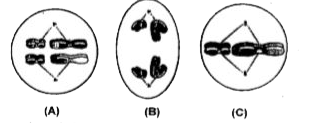Centromeres split and chromatids move apart during anaphase.
Step-by-Step Solution:
1. Understanding the Cell Cycle and Mitosis:
- The cell cycle consists of several phases, including interphase and mitotic phase (mitosis and cytokinesis).
- Mitosis is divided into several stages: prophase, metaphase, anaphase, and telophase.
2. Identifying Anaphase:
- Anaphase is the third stage of mitosis.
- It follows metaphase, where chromosomes are aligned at the cell's equatorial plane.
3. Role of Centromeres:
- Centromeres are the regions of a chromosome where sister chromatids are joined together.
- Each chromosome consists of two identical sister chromatids connected by a centromere.
4. What Happens During Anaphase:
- During anaphase, the centromeres split.
- This splitting allows the sister chromatids to separate from each other.
5. Movement of Chromatids:
- Once the centromeres split, the sister chromatids are pulled apart by the spindle fibers.
- The chromatids move toward opposite poles of the cell.
6. Conclusion:
- The statement "Centromeres split and chromatids move apart during anaphase" is true.
- This process is crucial for ensuring that each daughter cell receives an identical set of chromosomes.
---
- The cell cycle consists of several phases, including interphase and mitotic phase (mitosis and cytokinesis).
- Mitosis is divided into several stages: prophase, metaphase, anaphase, and telophase.
- Anaphase is the third stage of mitosis.
- It follows metaphase, where chromosomes are aligned at the cell's equatorial plane.
- Centromeres are the regions of a chromosome where sister chromatids are joined together.
- Each chromosome consists of two identical sister chromatids connected by a centromere.
- During anaphase, the centromeres split.
- This splitting allows the sister chromatids to separate from each other.
- Once the centromeres split, the sister chromatids are pulled apart by the spindle fibers.
- The chromatids move toward opposite poles of the cell.
- The statement "Centromeres split and chromatids move apart during anaphase" is true.
- This process is crucial for ensuring that each daughter cell receives an identical set of chromosomes.
Topper's Solved these Questions
- CELL CYCLE AND CELL DIVISIONBOOK - MODERN PUBLICATIONCHAPTER - CELL CYCLE AND CELL DIVISIONEXERCISE - QUICK (MEMORY TEST) (A.SAY TRUE OR FALSE)
1 Videos
- CELL CYCLE AND CELL DIVISIONBOOK - MODERN PUBLICATIONCHAPTER - CELL CYCLE AND CELL DIVISIONEXERCISE - QUICK (MEMORY TEST) (B.COMPLETE THE MISSING LINKS)
17 Videos
- CELL CYCLE AND CELL DIVISIONBOOK - MODERN PUBLICATIONCHAPTER - CELL CYCLE AND CELL DIVISIONEXERCISE - HOTS (HIGER ORDER THINKING SKILLS AND BRAIN TWISTING)( LONG ANSWER QUESTION)
1 Videos
- CELL : THE UNIT OF LIFE BOOK - MODERN PUBLICATIONCHAPTER - CELL : THE UNIT OF LIFE EXERCISE - Chapter Practice Test (Section-E)
1 Videos
- CHEMICAL COORDINATION AND INTEGRATIONBOOK - MODERN PUBLICATIONCHAPTER - CHEMICAL COORDINATION AND INTEGRATIONEXERCISE - Chapter Practice Test
16 Videos
Similar Questions
Name the stage of cell cycle at which one of the following events occur:
(i) Chromosomes are moved to spindle equator
(ii) Centromere splits and chromatids separate
(iii) Pairing between homologous chromosomes takes place
(iv) Crossing over between homologous chromosomes takes place
View SolutionCentromeres split, chromatids separate and move to opposite poles during
View Solution
Knowledge Check
In mitosis, the centromeres split and chromatids separate during :
AMetaphaseBAnaphaseCProphaseDTelophaseFor the stages of the cell cycle, select the correct option.
A. A chromosome is arranged at the equator - Metaphase.
B. Centromere splits and chromatids are separated - Anaphase I.
C. The pairing between homologous chromosomes takes place - Zygotene.AA and BBA and CCB and CDA, B and CAssertion: During anaphase, centromere of each chromosome splits and chromatids separate.
Reason: During anaphase, chromatids move to opposite poles.AIf both assertion and reason are true and reason is the correct explantion of assertionBIf both assertion and reason are true but reason is not the correct explnantion of assertion.CIf assertion is true but reason is false.DIf both assertion and reason are false.
In meiosis centromeres divide and chroma- tids separate during
View SolutionDuring which phase the centromere splits and chromatids move toward the opposite poles by the shortening of spindle fibers attached to centromeres ?
View SolutionWhich of the following events takes place during anaphase stage of mitosis
I. Spindle fibres attach to kinetochores of chromosomes
II. Centromeres split and chromatids separate
III. Chromatids move to opposite poles
IV. Nucleolous, Golgi complex and E.R. reform
View Solution$ The two strands of a chromosome are called sister chromatids
! The two sister chromatids get separated during Anaphase.
View SolutionCarefully observe the diagram given below and read the statement :-

(a) Chromosomes are moved to spindle equator (b) Chromosomes is made up of two chromatids
(c) Centromere slipt and chromatid separates (d) Chromatids start move to opposite poles
From the above events how many are correct for diagram B :-
View Solution
